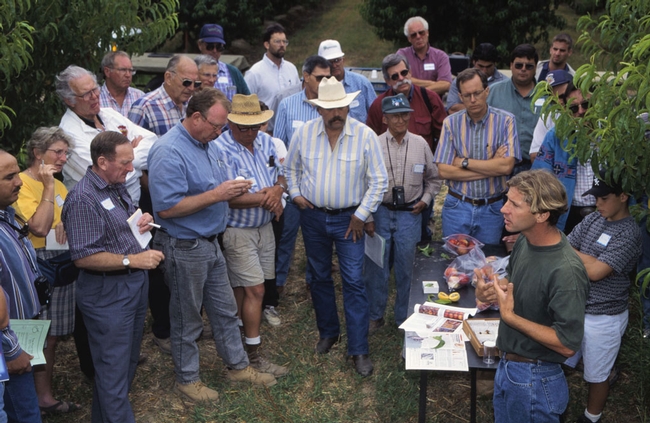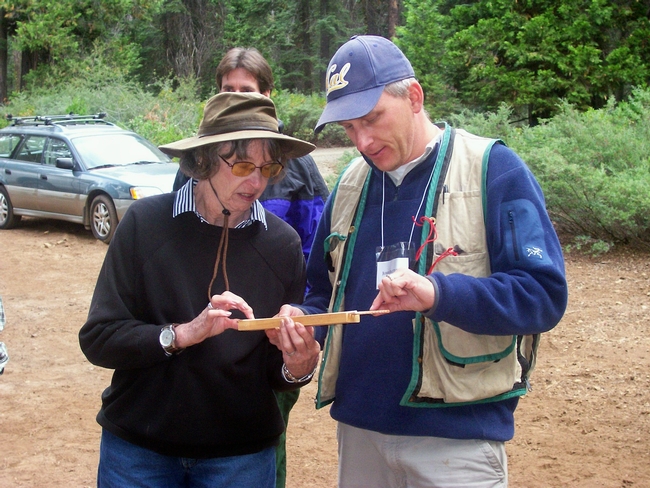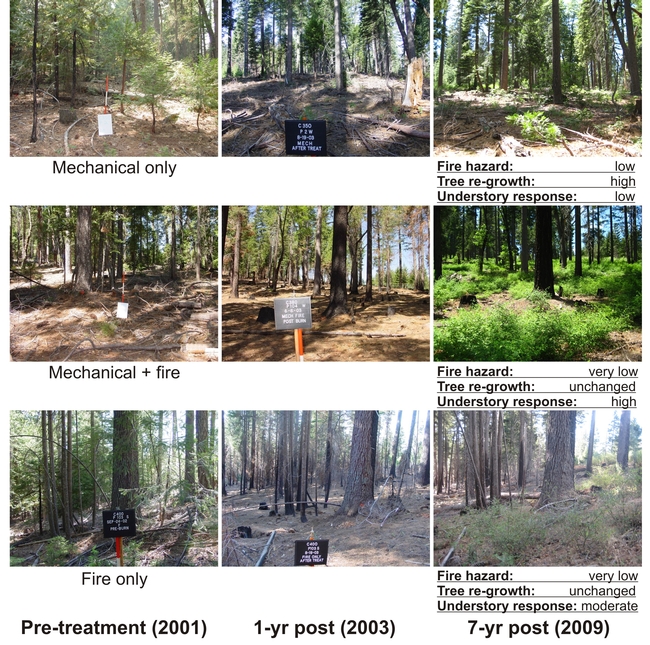Posts Tagged: John Battles
'Science' details an unconventional academic path
Throughout the United States, Cooperative Extension's 13,000 academics use new technologies to help solve problems faced by farmers, industries, natural resource managers and local communities, reported John Tibbetts in the AAAS publication Science.
The article included the thoughts of two relatively new UC Cooperative Extension academics and outlined a new UC program to support graduate students interested in cooperative extension careers.
Distinct skills are needed to be an effective cooperative extension academic. The role requires the ability to know and understand how to work with and through people, how to bring about change in communities and how to engage buy-in at the grassroots level.
"You should have good listening skills," added Lenya Quinn-Davidson, UC Cooperative Extension area fire advisor based in Humboldt County.
Quinn-Davidson also said she likes the diversity of her job. “I can be out in the field and then do a radio interview, work on a grant application, or host an event, and I'm always building relationships," she said.
John Battles, forest ecology professor at UC Berkeley said Cooperative Extension can offer an alternative academic career track for many students, but they need a way to learn the skills needed for extension success.
“In extension, you must communicate science effectively to the general public, and you don't have a 50-minute lecture to do it. You need to know how to facilitate a productive discussion in a public meeting, how to run that meeting so that everyone is heard,” he said.
To prepare students for extension jobs, UC Berkeley launched the Graduate Students in Extension program. The internship offers up to a year of funding for graduate students to conduct applied research projects and learn the principles of outreach.
Tapan Pathak, UC Cooperative Extension specialist in climate change adaptation in ag, also commented Tibbetts' article. He said extension specialists have the academic freedom to undertake research in their field as long as it addresses the needs of their clients.
The effects of density and high severity fire on tree and forest health
Hike off-trail through most any part of the Sierra Nevada and you may find yourself losing your hat to a low hanging branch, your shoe to a thicket of dead and dying brush, or your companion to the crevice hidden by the wall of young trees.
There is no doubt that the forests of the Sierra Nevada, while amazingly beautiful, have grown dense with vegetation. Consequently, forests have become increasingly susceptible to high severity fires, which negatively impact the forest's overall health and our ability to enjoy it.
There is a relationship between a healthy forest and its density. The denser the forest, the more competition individual trees have for valuable resources, such as water, light and nutrients. The effects of competition on tree growth and death are profound – the more trees per acre, the smaller the diameter of the individual trees (meaning less growth) and the higher the likelihood trees will be negatively impacted by pests, diseases, and poor health, ultimately leading to tree mortality. Theories in ecology, supported by field data and statistical analysis, predict that some trees will outperform others and the difference in performance increases with crowding. Unfortunately, evidence suggests that excess density is causing increased mortality in the Sierra.
John Battles, forestry professor at UC Berkeley and member of the Sierra Nevada Adaptive Management Project (SNAMP), is leading a team of UC Berkeley researchers and graduate students in developing vulnerability profiles that will help to quantify individual trees' probability of survival. The growth response of individual trees is the primary measure of forest health in the SNAMP study. The team believes growth is an excellent indicator of tree vitality and that a necessary (but not sufficient) condition for a healthy forest is healthy trees.
The team collected and processed more than 12,000 tree cores to develop long term growth and vulnerability profiles for different tree species. Their results supported the accepted notion that, in general, good growth was an indicator of good health. However, they also found that "bad years," when growth was substantially lower than normal, were strong predictors of death. In addition, they reported that bad years had a cumulative impact that spanned decades. In other words, the best predictor of potential death was for a tree to experience two or more bad years over the most recent 20 – or even 40 – years. The team has been working to translate these relationships between tree growth and survival to produce a vulnerability index by species and size. One goal is to have some sense on how vulnerable a stand is before many trees start to die.
Another key question being asked by SNAMP researchers is whether fuels treatment projects designed to modify fire behavior also improve forest health. Battles and his team hypothesize that thinning a dense forest will improve individual tree and overall forest health, as well as reducing fire risk. Resilience, or the capacity to recover from adverse conditions, is the goal. Histories captured in tree core samples show that trees can survive adverse conditions such as fire and drought. While studies have shown that properly implemented fuel treatments are effective at reducing hazardous fire potential, there are secondary ecological effects that can impact forest resilience either positively or negatively depending on the treatment type, timing and intensity. In a study at the UC Blodgett Forest Research Station, researcher Brandon Collins and others looked at large, dominant tree growth responses, measured seven years after the implementation of some of the most common fuel treatments, to estimate that forest's health. Across the five tree species analyzed, observed mortality and future vulnerability were consistently low in the areas where only mechanical treatment occurred. Fire-only treatment had results similar to areas that did not receive treatments for all species except Douglas-fir. Mechanical-plus-fire treatments, however, had high observed mortality and future vulnerability for white fir and sugarpine. Given that these large, dominant trees play a key role in terms of wildlife habitat, carbon sequestration and soil stability, these results have implications for understanding longer-term impacts of common fuel treatment types on forest resilience.
Through the analysis of tree core samples, Battles and his team hope to provide clarification on conditions that improve individual tree health and the overall health of the forest. The final report on SNAMP, with the results of the forest health study described here, will be available May 31, 2015, at http://snamp.cnr.berkeley.edu/.




